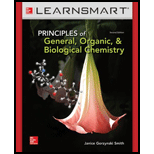
(a)
Interpretation:
The type of bonding present in potassium iodide
Concept Introduction:
Bonding:
The bonds are formed by sharing and transfer of one or more electrons present in a molecule. The atoms or ions present in a molecule are bonded together. The bonds can be formed as single, double and triple bonds. The bonds can be formed based on electronegativity value. There are few examples of bonds are given.
They are,
- Ionic bond: When electrons are transferred from metal atom to nonmetal atom, and as a result of interaction between oppositely charged ions and forms ionic bond. These types of bonds are known as ionic bonds.
- Covalent bond: These bonds are formed due to electrostatic attraction between atoms and its shared pair of electron. These bonds can able to choose their octet fill by sharing electron pairs between them. These are known as covalent bonds.
- Metallic bond: The metallic bonds are formed between ionized atoms of metal and the sea of electrons is present around them. The metal compounds generally have low electronegativity. It can be easily ionized and they can lose the outermost electron.
Electronegativity: The ability of atom to attract bonding pair of electrons is known as electronegativity. The electronegativity can be denoted as
(a)
Explanation of Solution
The potassium iodide
The compound pentane
(b)
Interpretation:
The compound potassium iodide
Concept Introduction:
Solubility:
The solubility is defined as the solid or liquid or gaseous substance which dissolves in suitable solvent. The solubilty of compounds also based on polar or nonpolar molecules. The nonpolar molecule has no separate positive and negative charge. Polar molecules have separate positive and negative charges.
(b)
Explanation of Solution
The compound potassium iodide
The compound pentane
(c)
Interpretation:
The compound potassium iodide
Concept-Introduction:
Refer: (b)
(c)
Explanation of Solution
The compound potassium iodide
Potassium iodide
The compound pentane
(d)
Interpretation:
The melting point of given compound potassium iodide
(d)
Explanation of Solution
The melting point of potassium iodide
The compound pentane
(e)
Interpretation:
The boiling point of given compound potassium iodide
(e)
Explanation of Solution
The boiling point of potassium iodide
The compound pentane
Want to see more full solutions like this?
Chapter 10 Solutions
Connect Access Card for Principles of General, Organic & Biochemistry
- Identify whether oxidation or reduction is needed to interconvert alkanes, alcohols,aldehydes, ketones, and acids, and identify reagents that will accomplish the conversionarrow_forwardWhat hydrocarbon with the molecular formula C4H10 forms three monochlorinated products? One is achiral and two are chiral.arrow_forwardlewis structure of CH3CH2CHNarrow_forward
- Identify the functional groups in the ball-and-stick model of elemicin, a compound partly responsible for the flavor and fragrance of nutmeg.arrow_forwardHow many structural isomers of C4H6 have exactly one ring?arrow_forwardDraw the structure for the following compound. (3R,5S,6R)-5-ethyl-3,6-dimethylnonanearrow_forward
- draw the structure of all monobromo derivatives of pentane, C5H11Br, which contain a 4 carbon chainarrow_forwardDraw all structural isomers of C6H12that are cyclic ?arrow_forwardCyclopentane has a higher boiling point than pentane even though both compounds have the same number of carbons (49 °C vs. 36 °C). Can you suggest a reason for this phenomenon?arrow_forward
 Chemistry: Principles and PracticeChemistryISBN:9780534420123Author:Daniel L. Reger, Scott R. Goode, David W. Ball, Edward MercerPublisher:Cengage Learning
Chemistry: Principles and PracticeChemistryISBN:9780534420123Author:Daniel L. Reger, Scott R. Goode, David W. Ball, Edward MercerPublisher:Cengage Learning
 Chemistry: The Molecular ScienceChemistryISBN:9781285199047Author:John W. Moore, Conrad L. StanitskiPublisher:Cengage Learning
Chemistry: The Molecular ScienceChemistryISBN:9781285199047Author:John W. Moore, Conrad L. StanitskiPublisher:Cengage Learning- Chemistry: Matter and ChangeChemistryISBN:9780078746376Author:Dinah Zike, Laurel Dingrando, Nicholas Hainen, Cheryl WistromPublisher:Glencoe/McGraw-Hill School Pub Co
 Introductory Chemistry: A FoundationChemistryISBN:9781337399425Author:Steven S. Zumdahl, Donald J. DeCostePublisher:Cengage Learning
Introductory Chemistry: A FoundationChemistryISBN:9781337399425Author:Steven S. Zumdahl, Donald J. DeCostePublisher:Cengage Learning




